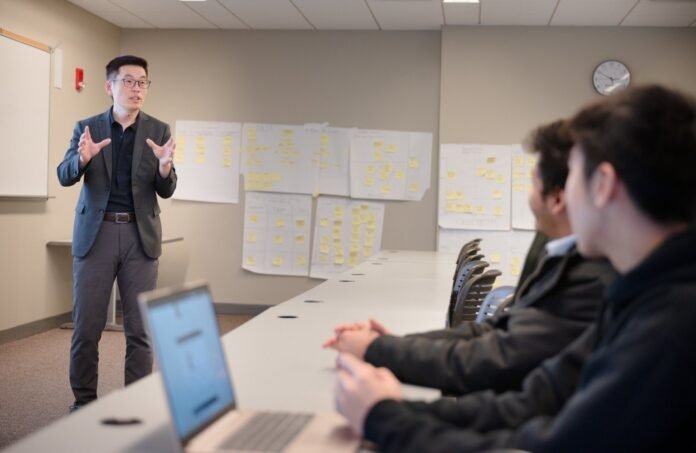Business
Professors at Rutgers Business School integrate generative AI to train students

Rutgers Business School (RBS) is innovating its coursework with technology to ensure students are prepared for the future, as artificial intelligence (AI) continues to be adopted by industry, and work processes evolve as a result.
Last year, RBS partnered with Google to provide AI-powered tools to students, faculty and staff, and it also announced a broad directive to integrate AI into the curriculum across all areas of study.
The focus on artificial intelligence included the creation of an MBA concentration in AI, a Master of Science in Marketing Analytics and Insights, and a Master of Accountancy in Accounting and Analytics, a program that offers a specialization in AI.
“Every student who graduates will have knowledge of AI for business. That was the main motivation,” said Professor Hussein Issa, who chaired a task force charged with integrating AI into undergraduate academic courses.
Lei Lei, Rutgers Business School’s dean, noted that it is vital for students to learn how to use emerging technologies that are changing work and the way people do business.
“Our ambition is to prepare students with the skills and talent most in demand by industry,” he said. “At RBS, we describe that preparation as future proofing.”
Rutgers provides the university community with free access to such AI-based tools as Microsoft Copilot, Google Gemini and NotebookLM. ChatGPT Edu is also available for a monthly subscription fee from the university’s software portal.
Management Professor Zeki Pagda introduced generative AI into his Management Consulting class after reading about how the U.S. government uses it to help employees improve their negotiating skills. He can select from dozens of scenarios and then assign ChatGPT a role to play. The simulation enables his undergraduate students to practice the negotiation styles he’s teaching them.
The student speaks to ChatGPT in the role-playing exercise, and ChatGPT responds in writing. “ChatGPT can play a role,” said Pagda. “It can ask a question and negotiate.”
Pagda explained that partnering them with AI is better because ChatGPT can respond with feedback, and the student can try again. Practice is essential in learning negotiation. With AI, the feedback is more meaningful than another classmate, who is also learning negotiation skills.
He is also able to create different scenarios, giving students an opportunity to practice the different negotiating styles. ChatGPT provides feedback based on the student’s words and tone.
“It’s able to challenge the students,” said Pagda.
Supply chain Professor Rudolf Leuschner started using generative AI in his graduate-level demand management classes more than a year ago.
He incorporated an assignment into his curriculum that requires students to feed AI their forecasts using the different methods he has taught them. The students ask AI to analyze the forecasts, allowing the large learning model to look for patterns. While the students are permitted to use AI to analyze the forecasts, they are required to critique the information it generates.
“I don’t want them to rely on AI tools, but I want them to be familiar with how to use them to make their output better,” said Leuschner.
He said that students were excited to use generative AI when it was novel, but now they’re more familiar with it. He still provides them with specific guidance on how he wants them to use it.
“There’s a level of scrutiny,” said Leuschner. “People aren’t really sure what to make of it or where its place is.”
Students in Professor Erich Toncre’s Marketing Strategy course use Generative AI as part of an assignment that requires them to find an article about a marketing strategy. He gives them latitude to choose a business they’re interested in, and then they must critique the strategy described in the article.
“The critique itself must be their own,” said Toncre. “They’re graded on their understanding of the marketing strategy and their ability to apply the concepts to other current business situations.”
The marketing strategy assignment allows them to use AI as a tool.
“If they use AI as a shortcut for working on the entire assignment, they’re using it wrong,” said Toncre. “They are not only committing an academic violation, but they’re also cheating themselves for not using it properly as a helpful aid.”
Business
The “Boring” AI Business Model Making Millionaires in 2025

In 2025, while the world gushed about flashy robots, talking cars, and futuristic gadgets, a group of young people quietly built an AI business so unremarkable at first glance that almost nobody noticed it. It wasn’t glamorous, it didn’t have a viral video, and it didn’t try to predict the next big trend. But it was making millionaires out of regular people… people who had nothing but grit, curiosity, and patience.
This is the story of Maya and her “boring” AI model, and how it reshaped not only her life but the lives of thousands who followed her blueprint.
Maya was 27 in early 2024, living in a one-bedroom apartment above a grocery store in a crowded city. She had a degree in literature, not engineering, and worked as a night-shift clerk in a local print shop.
She had no investors, no startup culture contacts, and no idea how to code beyond simple website builders. But she had two assets few people had: relentless curiosity and the habit of looking for problems that nobody wanted to solve.
One evening, while scrolling through forums about small business challenges, she noticed dozens of owners complaining about repetitive, mundane tasks: sorting invoices, tagging emails, filing customer questions, and moving data from one platform to another. It wasn’t glamorous work. It wasn’t on the cover of magazines. But it was expensive and time-consuming.
And something clicked.
“What if AI could quietly do all these boring tasks?” she wondered.
While the tech world chased billion-dollar breakthroughs in self-driving cars and virtual universes, Maya started tinkering with the “unsexy” side of artificial intelligence. She didn’t try to build a sentient assistant. Instead, she built small, focused AI “micro-tools” that automated the ugly, tedious back-office work of everyday businesses.
Maya’s first tool wasn’t impressive. It was a simple AI model that read PDF invoices, extracted key data, and entered it into spreadsheets for small business owners. She found an open-source language model online, watched tutorials for weeks, and cobbled together an interface using no-code platforms. She spent nights testing it on free samples and begging café owners to try it.
Her first paying client was a family-run furniture shop. They hated doing paperwork at the end of every week. Maya’s tool reduced their 6-hour weekly process to 30 minutes. They paid her $50 a month. She danced around her apartment with joy.
But Maya didn’t stop. She built a second micro-tool to categorize customer emails into urgency levels. A third to predict low inventory items. Each small AI bot solved one tiny, boring problem. Together, they saved small businesses hundreds of hours.
By mid-2024, Maya had 47 clients paying $30-$200 a month. Not life-changing, but enough to quit her print shop job. She then created subscription tiers and white-labeled her micro-tools so other freelancers could sell them too. Her pitch wasn’t sexy; it was practical. “Save time. Save money. Grow quietly.”
This was the turning point.
A former schoolteacher named Daniel, 32, bought a license to resell Maya’s AI bots in his own city. He signed up 20 businesses in a month. He made more than he’d made teaching full-time. A retired accountant named Lucia, 58, did the same. She introduced the tools to her network of small retailers and built a six-figure income in a year.
The “boring” AI model had become a movement… not of tech moguls, but of ordinary people solving ordinary problems.
Maya’s philosophy was simple:
Don’t chase hype.
Solve persistent problems.
Keep costs low and margins healthy.
Let others partner and profit.
Instead of selling one giant software platform, she sold dozens of tiny, niche AI “workers” that anyone could subscribe to individually. This modular approach allowed even small-town businesses to adopt AI at their own pace.
By early 2025, hundreds of resellers around the world were using Maya’s framework to deliver micro-AI services. Some ran one-person operations; others built small agencies. They weren’t Silicon Valley founders… they were baristas, teachers, retirees, and college kids who saw a need and used Maya’s blueprint.
One such story was Sophie, a 21-year-old student who had grown up watching her parents run a bakery. Sophie bought Maya’s AI invoicing and scheduling tools, customized them with her own branding, and started selling them to bakeries and cafés in her region. Within six months, she’d replaced her part-time job income. Within a year, she was making $12,000 a month… enough to pay off her student loans before graduating.
Then there was Amir, 44, a former mechanic who lost his job during an economic downturn. He learned how to use Maya’s training materials, packaged AI bots for auto shops, and made more money in his first year of self-employment than he ever had before.
The model worked because it wasn’t glamorous. No flashy ads. No wild claims. Just steady value. Maya called it “AI plumbing”… building the pipes that let small businesses run smoother.
She focused on four principles:
1. Accessibility: Make it cheap and easy enough for non-tech people.
2. Education: Offer plain-language training and support.
3. Flexibility: Let resellers white-label and adjust pricing.
4. Community: Encourage sharing improvements and templates.
By mid-2025, Maya herself wasn’t just running a business. She was leading a decentralized movement of AI micro-entrepreneurs. Her own income grew into the millions, but she always reinvested in building better training and tools.
And yet Maya stayed humble. She still lived in a modest apartment, still answered customer support emails personally, and still said no to investors who wanted to “scale aggressively.” She believed the real revolution wasn’t another billion-dollar tech giant but thousands of small, empowered entrepreneurs earning honest incomes from useful AI tools.
Her success attracted skepticism. Some said it was too simple. Others thought the big companies would crush her. But Maya knew she was in a different lane. She wasn’t trying to win a popularity contest… she was trying to solve real problems.
And as the economy shifted in 2025, her approach turned out to be exactly what people needed: stability, low overhead, and the ability to start small.
By late 2025, analysts began to notice. Articles described the phenomenon of “boring AI” making quiet millionaires. But those inside the movement already knew: it wasn’t about hype. It was about mindset.
Maya often told her community:
“Find a problem. Build the simplest AI solution. Offer it to the people who need it most. Repeat. Don’t try to impress. Try to improve.”
It was a model anyone could adopt. A 19-year-old in Manila built AI tools for local fishermen to predict tide patterns. A 63-year-old in Nairobi used AI bots to help farmers monitor soil moisture. A single mom in Toronto built an AI appointment scheduler for local hair salons. The stories poured in, all rooted in the same principle: simple solutions, consistent effort, and community sharing.
Maya had proven something profound:
You don’t need to invent the next flying car to become successful. You can build “boring” tools that make life easier… and people will pay for that forever.
Moral of the Story
In a world obsessed with hype and spectacle, quiet consistency and practical problem-solving can outlast trends. The “boring” AI business model shows that success isn’t about dazzling innovation… it’s about meaningful impact. When you stop chasing fame and start solving real problems, you unlock a sustainable path to wealth, freedom, and purpose. Even the most ordinary ideas, applied persistently, can change lives… including your own.
Business
The AI Movie Factory Is Ramping Up

“Because I know the rooster.”
Those were the words of a Baghdad-based director named Hasan Hadi when asked how he was able to corral not just a host of non-actor children for his new movie but a particular kind of junglefowl.
Hadi – his The President’s Cake will come out this fall from Sony Pictures Classics and was just chosen as the official Iraqi Oscar submission – made the comment to a pair of reporters at a dinner at the Toronto International Film Festival. While among the more colorful – and barnyardy – of the remarks uttered at the important early-September gathering, it was far from the only one emphasizing the uniquely human qualities of filmmaking.
Across the Canadian city, directors made statements that, as the algorithm rises, almost take on a political cast. Richard Linklater and Ethan Hawke stood in front of an audience and described the painstaking rehearsal for their movie about Lorenz Hart. (“Ethan and I have done our share of dialogue-ntensive movies,” Linklater said, “but this was something else.”) Nia DaCosta talked about how her feelings on Ibsen animated her need to redo Hedda Gabler. Paul Greengrass left audiences breathless with his latest neo-verite adventure that has Matthew McConaughey as an embattled bus driver saving children in the 2018 Paradise wildfires.
None of them mentioned AI explicitly. They didn’t have to. Their pro-human vehemence was evident in every quote and frame.
But a different vision of Hollywood was also playing out at the industry’s big convocation, as tech entrepreneurs pitched their own vision to the entertainment decisionmakers. People from Largo, which builds models to test movies using virtual audiences. Luma AI, whose executives think studios can deploy their video-generation tool to ramp up production (and ramp down sets). Genny, which uses Google’s VEO-3 to help documentarians create re-enactment footage with the push of a button. All of them were at TIFF too, trying to enact their own vision of the entertainment future. And while they rarely crossed paths with the humanists, they clashed with them ideologically just the same. Hollywood may only be big enough for one them.
Pull the camera back and you’ll suddenly see the same battle playing out everywhere, in boardrooms and courtrooms. Warner Bros. has just sued Midjourney, making similar allegations as Disney and Universal before it against the image-generation startup. Anthropic has just agreed to settle with three authors who sued the AI company for training its models on their books. If the settlement is approved, it could result in the company paying a total of $1.5 billion to hundreds of thousands of authors – but the judge in the case also cleared the way for tech companies to engage in such training without permission so long as they bought retail copies of the books.
Seeking to convey the stakes, two activists, Guido Reichstadter and Michael Trazzi, have gone on hunger strikes outside the San Francisco office of Anthropic and London office of Google’s DeepMind respectively. They say they won’t eat any food until the companies stop developing all new AI models, giving both a visual and historical dimension to the conflict.
Meanwhile, the startup Showrunner, with investment from Amazon, made waves when it said it would use AI for an internal experiment to restore some 43 minutes of lost footage from Orson Welles’ The Magnificent Ambersons. The announcement generated a backlash from the company managing Welles’ estate, which an official there calling the move a “purely mechanical exercise” that lacked “uniquely innovative thinking.”
And of course The Sphere just opened an AI-enabled re-formatted The Wizard of Oz, aided by Google and $80 million (a budget $15 million higher than the original’s in 2025 dollars). While eliciting rave reviews, the project also added in cameos for the CEOs David Zaslav and James Dolan who were not, according to most film historians, present on the 1939 MGM set.
After years of companies building tech and raising money, the introduction of AI into the house of storytelling is finally here. And media players need to decide whether they want to make up the guest bedroom.
It would also be a mistake to think AI will only be used on classic films – on films with few stakeholders. The tools pitched and implemented would be used to create what was once done by hand on sets and in marketing departments, automating the analogue, with all the labor and cultural consequences to go with it.
At a hearing for the Anthropic settlement, one of the author plaintiffs, Kirk Wallace Johnson, said he saw the proceeding as the “beginning of a fight on behalf of humans that don’t believe we have to sacrifice everything on the altar of AI.” Johnson is the author of The Feather Thief, a critically acclaimed 2018 true-crime book about a heist that made off with scores of centuries-old historical bird skins. You could say that he, too, knows the rooster.
This story appeared in the Sept. 10 issue of The Hollywood Reporter magazine. Click here to subscribe.
Business
How To Un-Botch Predictive AI: Business Metrics

Data scientists consider business metrics more important than technical metrics – yet in practice they focus more on technical ones. This derails most projects. So, why?
Eric Siegel
Predictive AI offers tremendous potential – but it has a notoriously poor track record. Outside Big Tech and a handful of other leading companies, most initiatives fail to deploy, never realizing value. Why? Data professionals aren’t equipped to sell deployment to the business. The technical performance metrics they typically report on do not align with business goals – and mean nothing to decision makers.
For stakeholders and data scientists alike to plan, sell and greenlight predictive AI deployment, they must establish and maximize the value of each machine learning model in terms of business outcomes like profit, savings – or any KPI. Only by measuring value can the project actually pursue value. And only by getting business and data professionals onto the same value-oriented page can the initiative move forward and deploy.
Why Business Metrics Are So Rare for AI Projects
Given their importance, why are business metrics so rare? Research has shown that data scientists know better, but generally don’t abide: They rank business metrics as most important, but in practice focus more on technical metrics. Why do they usually skip past such a critical step – calculating the potential business value – much to the demise of their own projects?
That’s a damn good question.
The industry isn’t stuck in this rut for only psychological and cultural reasons – although those are contributing factors. After all, it’s gauche and so “on the nose” to talk money. Data professions feel compelled to stick with the traditional technical metrics that exercise and demonstrate their expertise. It’s not only that this makes them sound smarter – with jargon being a common way for any field to defend its own existence and salaries. There’s also a common but misguided belief that non-quants are incapable of truly understanding quantitative reports of predictive performance and would only be misled by reports meant to speak in their straightforward business language.
But if those were the only reasons, the “cultural inertia” would have succumbed years ago, given the enormous business win when ML models do successfully deploy.
The Credibility Challenge: Business Assumptions
Instead, the biggest reason is this: Any forecast of business value faces a credibility question because it must be based on certain assumptions. Estimating the value that a model would capture in deployment isn’t enough. The calculation has still got to prove its trustworthiness, because it depends on business factors that are subject to change or uncertainty, such as:
- The monetary loss for each false positive, such as when a model flags a legitimate transaction as fraudulent. With credit card transactions, for example, this can cost around $100.
- The monetary loss for each false negative, such as when a model fails to flag a fraudulent transaction. With credit card transactions, for example, this can cost the amount of the transaction.
- Factors that influence the above two costs. For example, with credit card fraud detection, the cost for each undetected fraudulent transaction might be lessened if the bank has fraud insurance or if the bank’s enforcement activities recoup some fraud losses downstream. In that case, the cost of each FN might be only 80% or 90% of the transaction size. That percentage has wiggle room when estimating a model’s deployed value.
- The decision boundary, that is, the percentage of cases to be targeted. For example, should the top 1.5% transactions that the model considers most likely to be fraudulent be blocked, or the top 2.5%? That percentage is the decision boundary (which in turn determines the decision threshold). Although this setting tends to receive little attention, it often makes a greater impact on project value than improvements to the model or data. Its setting is a business decision driven by business stakeholders, representing a fundamental that defines precisely how a model will be used in deployment. By turning this knob, the business can strike a balance in the tradeoff between a model’s primary bottom-line/monetary value and the number of false positives and false negatives, as well as other KPIs.
Establishing The Credibility of Forecasts Despite Uncertainty
The next step is to make an existential decision: Do you avoid forecasting the business value of ML value altogether? This would prevent the opening of a can of worms. Or do you recognize ML valuation as a challenge that must be addressed, given the dire need to calculate the potential upside of ML deployment in order to achieve it? If it isn’t already obvious, my vote is for the latter.
To address this credibility question and establish trust, the impact of uncertainty must be accounted for. Try out different values at the extreme ends of the uncertainty range. Interact in that way with the data and the reports. Find out how much the uncertainty matters and whether it must somehow be narrowed in order to establish a clear case for deployment. Only with insight and intuition into how much of a difference these factors make can your project establish a credible forecast of its potential business value – and thereby reliably achieve deployment.
-

 Business2 weeks ago
Business2 weeks agoThe Guardian view on Trump and the Fed: independence is no substitute for accountability | Editorial
-
Tools & Platforms4 weeks ago
Building Trust in Military AI Starts with Opening the Black Box – War on the Rocks
-

 Ethics & Policy1 month ago
Ethics & Policy1 month agoSDAIA Supports Saudi Arabia’s Leadership in Shaping Global AI Ethics, Policy, and Research – وكالة الأنباء السعودية
-

 Events & Conferences4 months ago
Events & Conferences4 months agoJourney to 1000 models: Scaling Instagram’s recommendation system
-

 Jobs & Careers2 months ago
Jobs & Careers2 months agoMumbai-based Perplexity Alternative Has 60k+ Users Without Funding
-

 Education2 months ago
Education2 months agoVEX Robotics launches AI-powered classroom robotics system
-

 Podcasts & Talks2 months ago
Podcasts & Talks2 months agoHappy 4th of July! 🎆 Made with Veo 3 in Gemini
-

 Education2 months ago
Education2 months agoMacron says UK and France have duty to tackle illegal migration ‘with humanity, solidarity and firmness’ – UK politics live | Politics
-

 Funding & Business2 months ago
Funding & Business2 months agoKayak and Expedia race to build AI travel agents that turn social posts into itineraries
-

 Podcasts & Talks2 months ago
Podcasts & Talks2 months agoOpenAI 🤝 @teamganassi

